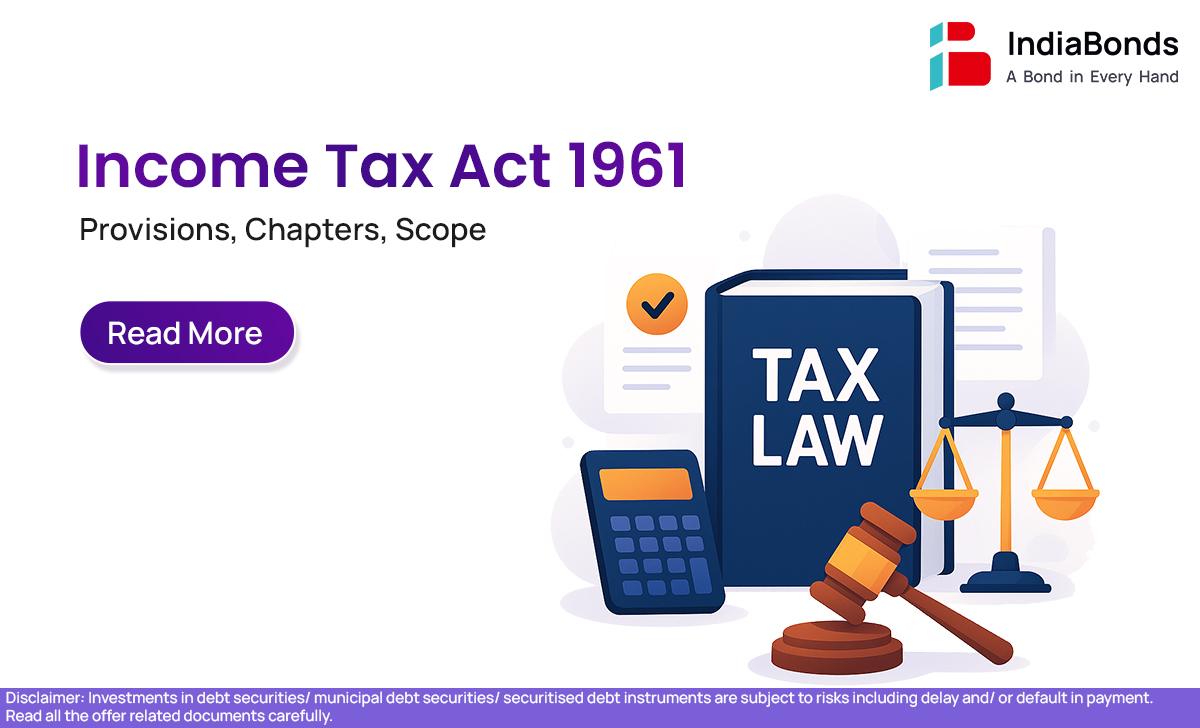Income Tax Act 1961 – Provisions, Chapters, Scope

Introduction
One Sunday morning, my uncle was happily polishing his scooter when the postman handed him a thick brown envelope. He opened it, read for a few seconds, and his face changed colour. It wasn’t a wedding invitation. It was a notice from the Income Tax Department.
“Beta, pata nahi yeh 1961 ka law kaise kaam karta hai… bas itna maloom hai ki paisa dena padega,” he sighed.
That’s the thing – most of us hear “Income Tax Act, 1961” and imagine it’s something only accountants or lawyers understand. But here’s the truth – this law isn’t some ancient, dusty file sitting in a government office. It’s quietly shaping how every working Indian earns, saves, and spends.
Let’s break it down so simply that even my uncle – who still pays his bills at the post office – could understand it.
What is the Income Tax Act, 1961?
The Income Tax Act, 1961 is India’s official rulebook for income tax. It started on 1 April 1962 and keeps getting updated because our economy, jobs, and ways of earning money keep changing.
Think of it like a huge map – it tells you:
- Who has to pay tax
- How much tax to pay
- What income is taxable and what isn’t
- What deductions and reliefs you can use to reduce tax
And here’s the fun part – it applies to everyone. Whether you’re a software engineer in Hyderabad, a farmer in Punjab earning non-taxable agricultural income, or a YouTuber in Jaipur making money from brand deals – this Act decides what happens to that income.
Income Tax Act Chapters and Sections
The law is divided into chapters (big topics) and sections (specific rules).
Example: If the Act were a Bollywood film, the chapters would be the main scenes, and the sections would be the dialogues. Some dialogues have become so famous that almost every taxpayer knows them:
- Section 80C – The go-to for saving tax through investments like PPF, ELSS, or life insurance.
- Section 10 – The list of incomes you don’t have to pay tax on.
- Section 139 – The “ITR rules” section, telling you when and how to file your return.
The Act has 23 chapters and over 300 sections, but don’t panic – just like you don’t remember every scene in a movie, you don’t need to know every section. Only the ones that apply to you.
Provisions of the Income Tax Act, 1961
The provisions are the “conditions of the game” – break them, and you pay the price; follow them, and you might even win (by saving money legally).
Some key ones are:
- Tax Rates – Higher income means a higher percentage of tax.
- Filing Returns – Do it before the due date or risk penalties.
- Deductions & Exemptions – Reduce your taxable income by investing in approved schemes or expenses (Sections 80C, 80D, etc.).
- Advance Tax – If you owe over ₹10,000 in tax for the year, you can’t wait till March to pay it.
- TDS (Tax Deducted at Source) – Tax is deducted before you even see the money.
- Penalties – Hide income or file late, and you’ll face fines or worse.
Example: Kavita, a boutique owner in Bhopal, earns ₹9 lakh a year. She invests in ELSS (Section 80C) and buys health insurance (Section 80D), reducing her taxable income. She files her return on time, avoids penalties, and saves thousands.
What is the Scope of Income Tax Act, 1961?
The scope tells you whose income gets taxed and which income is taxed.
It depends on your residential status:
- Resident – Taxed on global income.
- Non-Resident (NRI) – Taxed only on income earned or received in India.
The Act covers:
- Salary
- Business or professional income
- Capital gains (selling shares, property, etc.)
- Rent from house property
- Other sources (interest, lottery, etc.)
Example: Rohan, living in Pune, earns from his job in India and also rents a house in Dubai. Since he’s a resident, both incomes are taxable here. But if he were an NRI, only the Indian salary would be taxed.
Conclusion
The Income Tax Act, 1961 is not some scary monster. It’s a system that ensures everyone contributes their fair share while also rewarding you for smart financial planning.
The trick is to know the rules that apply to you – not all 300+ sections. Once you do, paying tax stops feeling like a punishment and starts feeling like part of the deal for living in a country that works for you.
FAQ
Q1: What is the scope of the Income Tax Act, 1961?
It defines who has to pay tax in India and on what income, based on residential status and the source of income.
Q2: How many chapters are there in the Income Tax Act, 1961?
There are 23 chapters covering different tax aspects.
Q3: What is the 14 provision of Income Tax Act?
Section 14 divides income into five heads – salary, house property, business/profession, capital gains, and other sources.
Q4: Which chapter of the Income Tax Act, 1961 deals with authorities?
Chapter XIII talks about the income tax authorities and their powers.
Disclaimer : Investments in debt securities/ municipal debt securities/ securitised debt instruments are subject to risks including delay and/ or default in payment. Read all the offer related documents carefully.
































